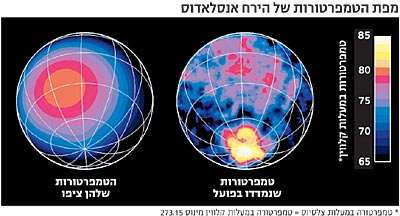Observations by the Cassini spacecraft on Saturn's moon Enceladus revealed that its south pole is hotter than the rest of its regions and is shooting jets of water vapor into space.

Temperature map of the moon Enceladus
The moon Enceladus, which orbits the planet Saturn, is a block of ice with a diameter of 500 km. It has an atmosphere and a "hot spot" at its south pole, and it shoots water vapor into space at a rate of about half a ton per second.
The discovery of such features in a celestial body apparently too small for its core to be hot greatly amazed a group of European and American scientists. They admitted this when they published last week the latest data collected by the "Cassini" spacecraft as part of its mission to study Saturn and its moons.
Cassini, a spacecraft about the size of a small bus, was launched in 1997. It arrived at Saturn in July 2004, after a flight of three billion km. In January, Cassini landed a European lander on Titan, Saturn's mysterious moon (which has an atmosphere denser than Earth's).
Cassini then flew past other moons of Saturn. It passed by Enceladus in February and March, and each time its instruments picked up strange behavior of the small moon's magnetic field.
In July, Cassini passed within 175 km of Enceladus and captured clear evidence of the existence of an atmosphere, containing water vapor, carbon dioxide and organic chemicals, above the moon's south pole. She also discovered signs that the surface of the moon at its south pole is warmer and younger than its equatorial and northern hemisphere regions.
The equatorial region was found to be scarred with ancient craters - evidence that it has not changed for billions of years - while the South Pole region has parallel fissures, similar to those on the surface of the Earth's glaciers, and is strewn with blocks of ice the size of houses.
"It must be remembered that Enceladus is quite small, so its gravity is not great," said Michelle Doherty from Imperial College London. "If there is an atmosphere there, you would expect it to disappear quite easily from the face of the moon."
Researchers have no idea why Enceladus, which is mostly minus 200 degrees Celsius, developed a warmer (but still very cold) region at the south pole. This may be evidence that tidal forces are squeezing the moon as it moves in its elliptical orbit around Saturn. It is also possible that it is residual heat from the decay of radioactive elements in the moon's core. The gases may be released into the atmosphere in eruptions from the South Pole.
The researchers believe that the amount of water released from the moon was even enough to form one of Saturn's thinner rings.
"The difficult part to digest is the existence of a heat source on Enceladus that is capable of operating for four billion years," said John Spencer of the Southwest Research Institute in Boulder, Colorado. Caroline Forko of the Boulder Space Science Institute, who heads the imaging team for the Cassini mission, said that "it's just one of Saturn's mysterious moons, and we now have a bird's-eye view of it."
